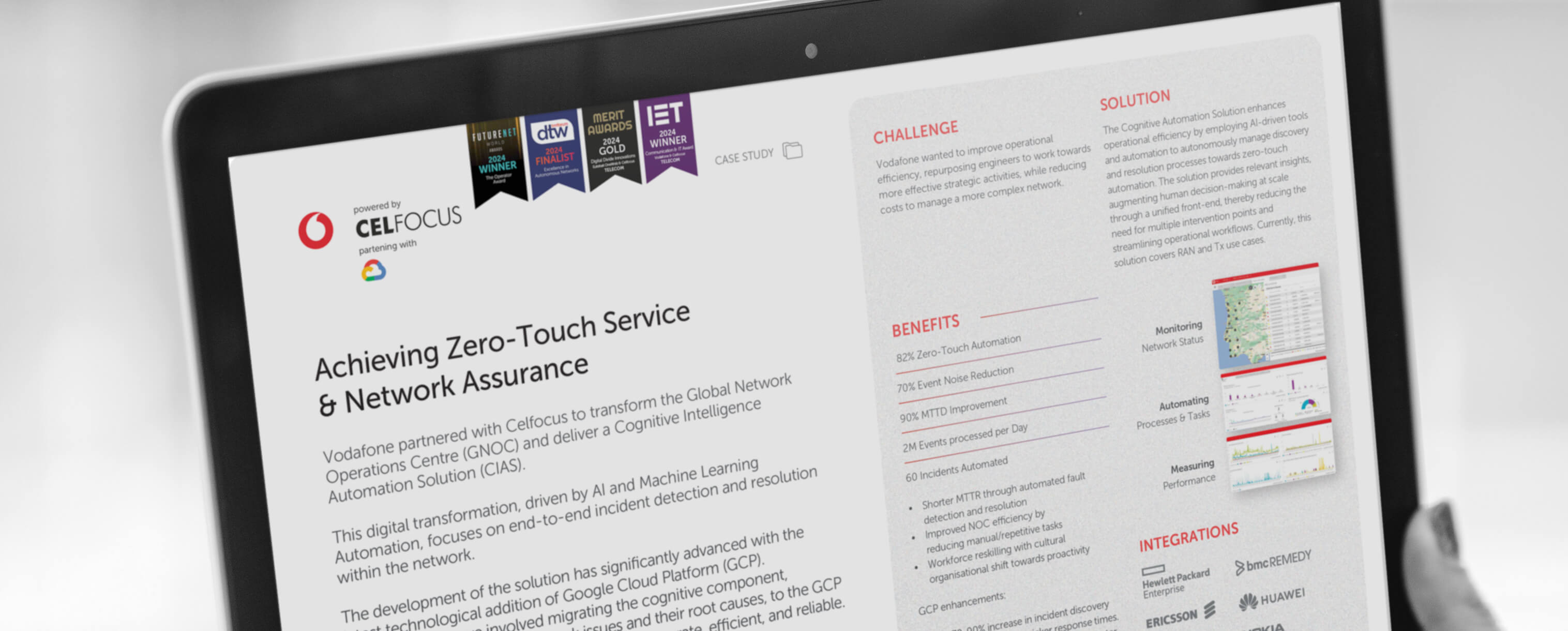|---Module:text|Size:Small---| Communication Service Providers (CSPs) have been undergoing a paradigm shift towards autonomous networks, aiming to increase operational efficiency, service reliability and cost-effectiveness. TM Forum’s Autonomous Networks (AN) framework provides a structured model for this evolution, categorising automation maturity into five levels – from basic manual operations (Level 0) to fully autonomous and self-governing networks (Level 5).
However, the transition to higher levels of autonomy is not only a technological challenge, but it also requires a strategic transformation of Operations Support Systems (OSS). As Gartner highlights in its research on The 4 Phases of OSS Transformation for Autonomous Network Operations, achieving full autonomy demands a multi-phase approach, addressing system modernisation, AI integration, and closed-loop automation.
TM Forum’s Autonomous Networks Levels
TM Forum defines five levels of autonomous networks:
- Level 0 - Manual Operations: Processes are fully manual, therefore human intervention is required for all network management tasks.
- Level 1 - Assisted Operations: Basic automation is introduced, but humans are still responsible for all important decisions.
- Level 2 - Partial Autonomous Operations: AI and automation begin handling repetitive tasks, reducing human workload.
- Level 3 - Conditional Autonomous Operations: The network predicts and resolves certain issues with minimal human oversight.
- Level 4 - High Autonomous Operations: Self-optimising capabilities emerge, but human intervention is still available as a fallback.
- Level 5 - Full Autonomy: The network operates independently, self-configuring, self-optimising, and self-healing in real-time.
For many CSPs, the goal is to achieve Level 4 or 5. Nevertheless, Gartner’s analysis states that most of them are still in Level 1 or 2, struggling with fragmented legacy systems and limited AI readiness. To progress, CSPs must rethink their OSS strategies, following a structured transformation process.
Gartner’s Model for OSS Evolution
Gartner outlines a four-phase transformation model for evolving OSS into Autonomous Operations Systems (AOS), a critical step in achieving network autonomy.
Phase 1: Clean-up and Modernisation
In this phase, before automation can scale, legacy OSS systems must be streamlined. It involves:
- Eliminating redundant applications and consolidating OSS functionalities.
- Upgrading outdated systems to cloud-native architectures.
- Creating a target OSS blueprint that enables closed-loop automation at multiple levels (network, service, and order).
For TM Forum, this phase is essential for CSPs moving from Level 1 to Level 2.
Phase 2: Building the AI Foundation
Once OSS systems are modernised, the next step is to integrate AI and automation. It involves:
- Establishing a centralised data platform for real-time analytics.
- Developing Machine Learning models to detect patterns and optimise performance.
- Mapping full network topologies to support AIOps (AI-driven operations).
For TM Forum, this aligns with CSPs aiming for Level 2 to Level 3, where AI-driven predictive capabilities become viable.
Phase 3: Closed-Loop Automation
With AI models in place, the focus shifts to implementing automated and self-regulating processes. It involves:
- Domain-level closed-loop automation (e.g., optimising radio access networks).
- Resource and service-level automation, aggregating key performance indicators (KPIs) for real-time decision-making.
For TM Forum, this corresponds to Level 3 to Level 4, where networks can proactively detect and resolve issues.
Phase 4: Full AI-Driven Autonomy
The final step is enabling self-configuring, self-healing and self-optimising capabilities, transforming networks into truly autonomous systems. It involves:
- Expanding automation to order management and service experience.
- Integrating Digital Twins to simulate network behaviour and predict failures.
- Continuously refining AI models through business process reengineering.
For TM Forum, this phase supports CSPs reaching Level 5, where the network functions without requiring human intervention.
The Role of AI and Digital Twins in Enabling Autonomy
AI enables predictive maintenance, real-time traffic optimisation, and automated fault resolution, ultimately forming the backbone of autonomous networks. Gartner emphasises that Digital Twins - virtual replicas of physical networks – are becoming a key enabler of self-governing networks.
As Gartner states, “Transforming OSS into an Autonomous Operations System (AOS) will revolutionise network automation, orchestrating complex processes with minimal human oversight.” This aligns with TM Forum’s vision that higher automation levels require intelligent, AI-driven OSS architectures.
What should CSPs do?
So, to successfully transition towards fully autonomous networks, CSPs should focus on the following strategies:
- Develop a structured automation roadmap: align network automation goals with business objectives and customer needs.
- Invest in AI-ready OSS platforms: adopt cloud-native, API-driven OSS architectures that support real-time analytics.
- Leverage Digital Twins: use network simulation models to improve decision-making and reduce operational risks.
- Adopt closed-loop automation: shift from reactive to proactive network management, ensuring better service quality.
- Collaborate with technology partners: engage with leading AI and cloud providers to accelerate OSS modernisation and AI adoption.
The journey towards autonomous networks is complex but achievable. By integrating TM Forum’s automation maturity model with Gartner’s phased OSS transformation, CSPs can create a structured and AI-driven roadmap to achieve full autonomy. As AI and Digital Twins continue to evolve, CSPs that strategically modernise their OSS will gain a competitive edge, enabling seamless and intelligent network operations.
|---Module:text|Size:Small---| At Celfocus, we have been helping clients progress to Level 4 and Level 5 for several years now, integrating AI and automation to enhance customer experience and operational efficiency. However, as networks become increasingly complex, achieving full autonomy requires greater visibility into network resources and new approaches to data representation.
Celfocus approaches digital network transformation by first tackling process and solution design with an E2E holistic perspective covering the entire CSP lifecycle (from planning to assurance). To do this, we focus not only on the network-centric process itself but also on business interactions and their value by using our proprietary facilitation maps technology, bringing all the information together to be discussed by multiple teams. This approach allows us to break existing silos and increase synergies between business, engineering, and operations teams, while also working towards reducing the complexity and overlapping of solutions. With the process and solution design in place, our vision is to achieve a fully digital network experience for customers powered by a digital network management platform that contains all the right technological foundational capabilities to boost teams’ efficiency and TTM while delivering automated processes that return value to both business and operations.
Our approach is inspired and refined from our long-term collaboration with CSPs, including deployments in 12+ countries on a global level. It leverages large amounts of data produced by CSPs, combining advanced analytics, Artificial Intelligence & Machine Learning (AI & ML) and orchestration & automation solutions combined, to enable operators to automate planning, readiness, fulfilment, and assurance with minimum human intervention.
Following TM Forum’s model as well as Gartner’s guidelines, we are embracing a new wave of innovation, collaborating with partners and clients to bring greater intelligence to network operations and management. Our solutions have already proven instrumental in enhancing service impact analysis and root cause identification. Yet, this is just the beginning - Digital Twins unlock new possibilities that will drive even greater value for operators in the future.





















